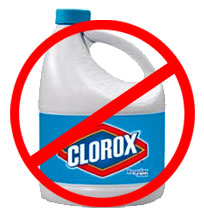
How to Clean a Wood Deck the Right Way in 2025
Many homeowners make the mistake of using chlorine bleach to clean their deck, thinking it will effectively remove mold and mildew. However, using bleach can cause long-term damage to your wood, leading to discoloration, splintering, and premature aging. The good news? There’s a safer and more effective way to clean your deck in 2025.
Why You Should Avoid Chlorine Bleach on Your Deck
Chlorine bleach (sodium hypochlorite) is a powerful sanitizer that kills bacteria and viruses, but it is not designed to clean wood decks. Here’s why using bleach is a bad idea:
- It Damages Wood Fibers: Bleach destroys lignin, the natural glue that holds wood fibers together. This weakens the wood, causing it to splinter and turn an unattractive gray color.
- It Doesn’t Kill Mold at the Root: Mold has deep roots in porous surfaces like wood. Bleach only removes mold on the surface, while the water content of bleach actually feeds the mold underneath. This often leads to faster, darker regrowth.
- It Strips Deck Stains and Sealers: If your deck is stained or sealed, using bleach can cause premature failure, fading, and a blotchy appearance.
- It Harms Surrounding Plants: Bleach runoff can kill grass, flowers, and landscaping around your deck, requiring extra precautions to protect your yard.
When it comes to chlorine bleach, think of it as a household cleaner for non-porous surfaces—kitchens and bathrooms—not for outdoor wood decks.
The Best Way to Clean Your Wood Deck in 2025
If you want a safe and effective way to clean your deck, use Restore-A-Deck Cleaner. This specialized wood cleaner is designed to remove dirt, mildew, and stains without harming the wood’s natural structure.
Why Restore-A-Deck Cleaner is the Best Choice:
? Safe for Wood: Unlike bleach, it preserves the lignin and fibers, keeping your deck strong and looking great.
? No Power Washer Needed: The formula is strong enough to clean the wood with just a garden hose. Simply apply, let it sit for 10–15 minutes, and rinse off.
? Safe for Plants and Grass: No need to cover or protect surrounding vegetation—it won’t cause harm.
? Prepares Wood for Staining: If you plan to stain or seal your deck, Restore-A-Deck Cleaner ensures a clean surface for the best adhesion and longevity.
How to Use Restore-A-Deck Cleaner:
- Mix the cleaner according to the instructions.
- Apply with a pump sprayer, brush, or roller.
- Let it sit for 10–15 minutes.
- Rinse thoroughly with a garden hose or pressure washer on low.
Final Thoughts
To keep your deck looking its best, avoid using chlorine bleach, which can do more harm than good. Instead, choose Restore-A-Deck Cleaner for a deep clean that protects your wood and extends the life of your deck.
For the best results, get Restore-A-Deck Cleaner online or at your local hardware store today!

